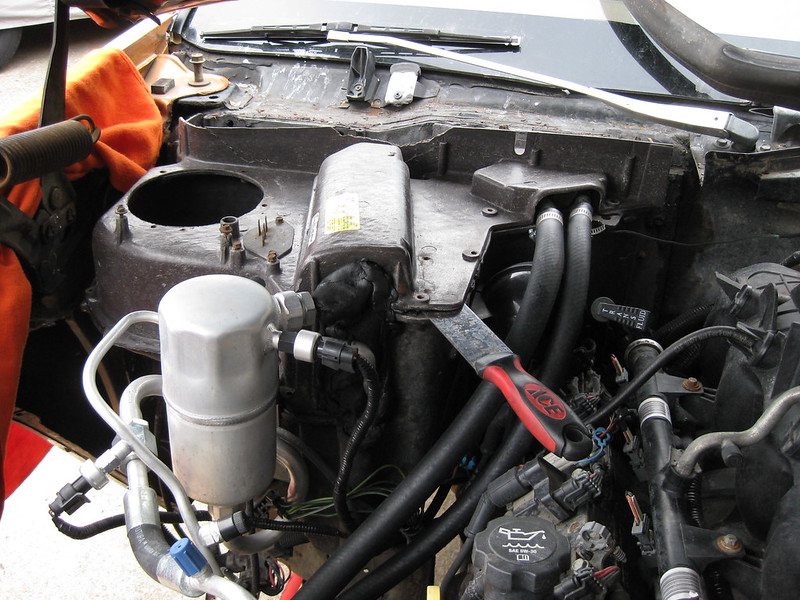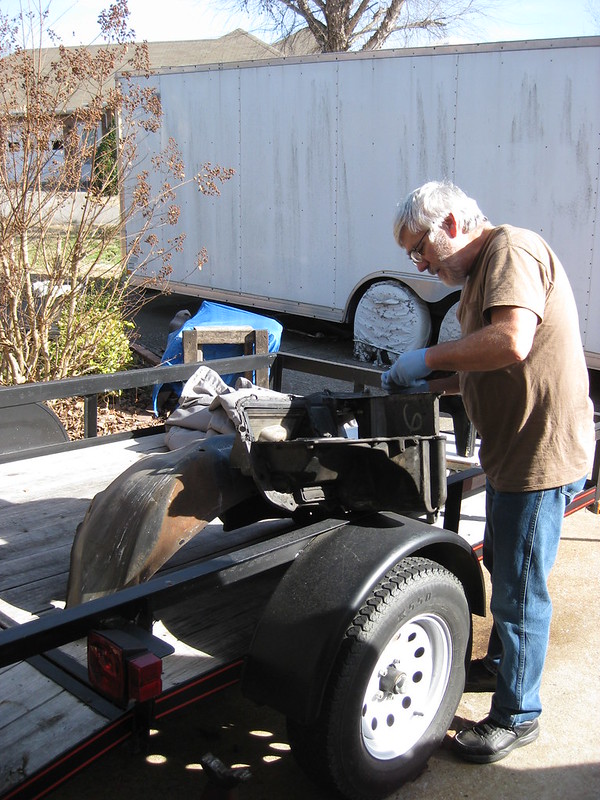I went scrounging at the scrapyard and found a couple panels to turn into floorboards. I believe they are from a washing machine. Several years ago while I was there I had noticed a piece in the back with casters on it that would be perfect to make an engine stand. I need something to mount the old engine from The Caprice onto so I can finally get it out of my driveway and I thought if I could find something similar to what I had seen before I would pick it up. To my surprise that piece was still laying there in the very back of the yard so I snagged it also.
I was sorely let down when I checked the floorboards after a big rain and found water again. This time, however, it was much less and I was easily able to tell where it was coming from. It was from the lower heater box. I had sealed the top of the heater box earlier, but apparently the lower portion was having issues also. This was a big let down because I was ready to move on to putting the carpet in and being finished and I knew how much work was going to be involved in removing and repairing the heater box. This would have been so much easier when I had the fender, hood and engine removed. The heater box issue is very well known to people who own these cars. It's not an if it has a leak, but rather has the leak been fixed yet.
I had a more than the usual amount of setbacks during this process, but the weather suddenly warmed up into the 60s, so regardless of how many things went wrong I'll take that over working in 15 degree weather. When I was removing the lower fender brace I began to feel a strange tension on the ratchet. When I looked I noticed the lower brace had twisted over 360 degrees. I was able to untwist it some by reversing the ratchet and I will still need to repair it further before installation.
The inner fender needed to be removed to gain access to the heater box. Since I will already have the fenderwell out I'm going to take it and the battery tray to be sandblasted and powder coated since the rust in that area is significant enough that it will likely cause issues within several more years.
I don't think it is supposed to come out with the fender on, but I didn't want to remove the fender because I would also have to remove the hood and that is not a one man job. The inner fender came out after a lot of persuasion.
Here is a better view of the afflicted area. Often the drain here can clog and cause issues, but I had already cleaned mine out and knew it wasn't the problem. Also, the grommet at the bottom of the wiring harness was difficult to remove.
I used windshield sealant when I installed the top of the heater box last time and I did a very, very thorough job. As a result the lid was absolutely stuck. I went around the entire box using a scraper to remove the seal, trying as much as possible not to pry on the old fiberglass.
Despite my best efforts the box broke in two pieces along a previous stress crack. I was fortunate that it came out in only two pieces. The copious amounts of sealant can be seen below.
There were a few wires that were still in place but not being used anymore in the engine bay. I didn't remove them previously because getting access to the firewall grommet was too difficult but because I now have everything off there's no reason not to clean up the rest of the remaining wires. A while back I explained how the new downsized Caprices for '77 used a very early diagnostic system that added a great many number of wires to the harness. There were two ports for this diagnostic system that a very early style computer system would plug into. I previously removed the one on the driver side and now I'm going to remove the one on the passenger side that mounts on top of the heater box. There is also some wiring for the old AC compressor and components that I'll be removing.
It was Christmas at this point and my mother and father-in-law came down to visit. My father-in-law accompanied me up to the country where I have a parts car stored so I could make use of the heater box top. Taking our time and being careful it came off without any trouble.
The lower section of the heater box was problematic to remove from The Caprice. There were some things keeping the box from releasing from the firewall, but we couldn't tell what they were. One thing I thought was an issue was this rod that controls the blend door. I thought I needed to remove this clip but couldn't figure out how to release it without breaking it. Fortunately I realized that removing it wouldn't do any good because the other end of that rod is connected to the heater box. I ended up removing the rod from the interior of the car which allowed it to come out with the heater box. The other issue holding the box in place was a hidden bit of silicone put there by someone in the past and another vacuum line.
After tackling those things I was able to get the box off of the firewall, but then it wouldn't come out of the engine bay. After a lot of finagling I was able to free the box, aided by removing the coil packs. Also, I was not able to remove the evaporator core from the box with the lines attached because one was a solid hard line and the other didn't have enough play in the hose, so now I'll also have to recharge the system.
While I was working on the firewall my father-in-law cleaned all of the old sealant off the heather box, top and bottom, and also cleaned both of them with Dawn soap and a toothbrush. That was a time consuming process.
I cleaned the mounting surfaces on the firewall with a combination of wire wheels, wire brushes and sanding discs on the pneumatic grinder. My air tank isn't very large so I would switch between these while the air tank filled back up. I probably crawled in and out of the wheel well thirty times. I had cramps in places I forgot existed.
After grinding down all of the rust I coated the area with rust inhibitor and left it while we went to get lunch. I cleaned it off when we got back and then cleaned the area with wax and grease remover. After that I masked the area off with tape and then followed that up with paper and filled the hole with cardboard.
I first laid down a couple coats of self-etching primer and then about three coats of semi-gloss black.
I went ahead and sanded and painted some other areas while I was in there. There was a significant amount of surface rust below the heater box from years of leaking, but nothing had gone further than just surface rust. I sanded it down to metal like the rest of the gasket area.
While I was removing the heater core I noticed something down inside the box. I found this old lighter. It's pretty small for a lighter. I put a quarter in front of it for comparison in the picture below. When I opened it a part of the flint bracket fell off and fell on the ground and we still haven't been able to find it. I've owned this car for 22 years, and it has been in the family longer than that, so this lighter has been riding around with me all these years and I never knew it.
The lower heater box had a couple cracked spots and a hole. I know at least one of them got done when we were installing this engine. I'll have to patch them.
The new-to-me heater box lid is in better shape than my old one was, but it is a little more faded because before I bought the parts car it had sat outside with no engine or hood for an unknown amount of time so the UV light had caused some fading.
My first plan was to remove the old heater box to firewall seal completely and replace it with windshield sealant, but after seeing how thick the gasket was I changed plans. I was able to remove the gasket in one piece without any tears. I cleaned it with Dawn dish soap, water and a toothbrush. Because it was still in such good shape I plan to run a small bead of windshield sealer on the front and back of the gasket and reinstall it.
I then proceeded to do what is likely one of the worst fiberglass repair jobs in history. I have left myself a lot of sanding in the future. I purchased a fiberglass repair kit from a parts house and it did not provide enough woven cloth to cover all of the areas so I will need to wait to buy another kit. It was Christmas day so there was no chance of finding anywhere to buy another that day. I'll repair the next hole and then sand everything down. I'll need to wait to see how the final result looks before I decide if I'm going to paint the entire box or just the areas seen here. I prefer the look of the original fiberglass coloring, but given the repairs and the new faded top I may end up painting it all.
























